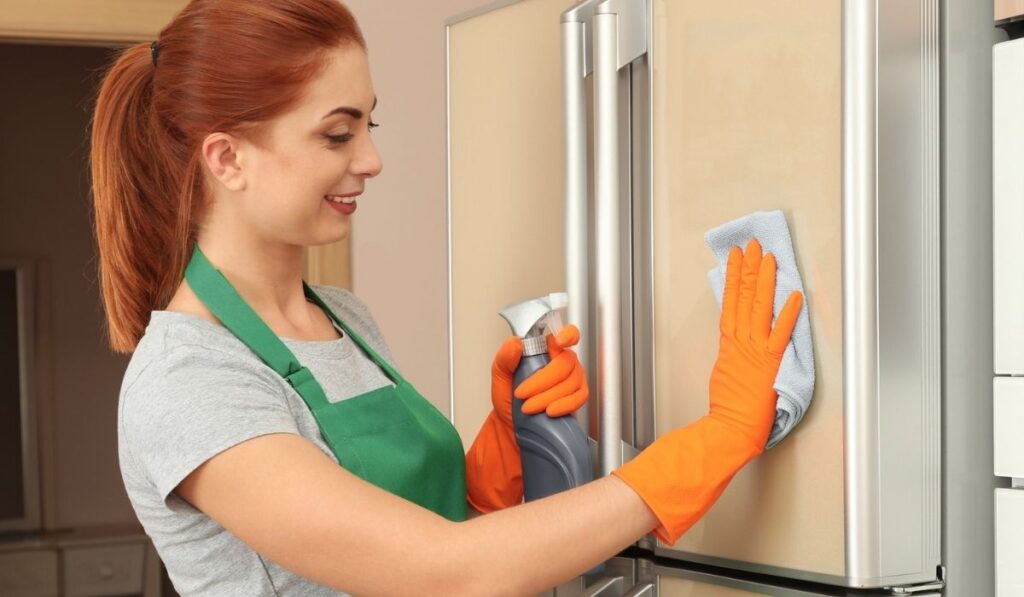The refrigerator is one of the most frequently used kitchen appliances, making it particularly susceptible to pesky dents and damages. The good news is that you can try to fix these damages without involving the expensive services of a professional.
To fix a dent in your fridge door without a repair service, you can try the hot and cold air method using a hairdryer, dry ice, or condensed air. Other preferred methods may include using a suctioning tool such as a dent remover kit or a household plunger that will pull the dent out.
In this article, we’ll review the steps to take to fix your fridge door without professional help. You’ll be able to try some of these methods with the equipment you already have at home, while others might require a trip to the nearest hardware store.
How to Remove a Dent From a Fridge Door

There are two primary methods for removing a dent from your refrigerator door without the service of a repairman. Let’s look at both.
Method One: The Use of Hot and Cold Air
- Blow a significant amount of hot air
Take your hairdryer or a heat gun, if you have one, and direct the hot air straight at the dent until it disappears. It is necessary to thoroughly heat the metal. Then allow it to cool for about a minute.
The metal will expand from this procedure. When you allow the metal to cool, it will compress, and it may return to its original shape.
If you’re interested in trying a heat gun, check out the SEEKONE Heat Gun (on Amazon). - Make use of dry ice
Dry ice is extremely cold. The metal of your fridge door may contract with the cold, thereby repairing the damage. Nothing more than holding the ice against the dent is required, but you may wish to cover the ice in a soft cloth to protect your refrigerator from scratches.
Keep the ice in place for at least a minute, or until you can tell that the metal is no longer hot to touch. Put on protective gloves before you begin the process. Dry ice will burn your fingertips just as much as a hot burner will do. - Blow it with cold condensed air to cool it down
Take a deep breath and reach for that can of compressed air next to your computer, the one you used to blow dust off your keyboard. Now comes the exciting part. Ignore the instructions that you should not turn it upside down.
While holding the can upside-down, blow air into the dent. This will create a cool condensation that will blow out. Give it a couple of strong whacks. It’s chilly enough that the dent may compress and self-heal because of the cold. Ensure to avoid contact with your skin because it burns the skin as much as dry ice.
Method Two: The Use of Suctioning Tool
- Clean the dent as much as possible
Occasionally, dent kits will include a dent cleaning solution. However, most of the time, it’s merely isopropyl alcohol. It should be rubbed on the affected region to eliminate any dirt. Because you’ll be using adhesive for this procedure, the glue must be able to adhere well.
Rust, finishes, and filth will cause the adhesive to come away easily. Cleaning it may cause the finish to be removed. Therefore, use this procedure only as a last option. - Purchase a dent remover for your automobile
It is possible to purchase dent removers online, in large box shops, or at auto parts stores. We recommend trying the Inscape Data Dent Puller (on Amazon).
These dent removers are equipped with little suction cups that are attached to the dent, often using a hot glue gun.
Glue the suction cup from an automobile dent remover to the surface of your fridge. Prepare your hot glue gun by heating it. Select a suction cup that is slightly larger in diameter than the dent.
Place the cup on the dent after applying a small amount of adhesive to it. This stage may be completed with any hot glue gun, but a high-temperature gun may be preferable. - Place the bar at the top of the page
On the back of the suction cup, there will be a screw that will tighten the cap. It is supported by a bar, which has two plates on either side of it.
Once the bar is in place, attach the knob to the rear of the suction cup by screwing it into place. Lightly screw it into place using a hex key. Don’t put too much pressure right now. Everything isn’t exactly in the right spot.
Place the plates adjacent to the little cup so that they are easily accessible. Most of these tools contain an adjustment mechanism for the two plates that provide leverage for pulling.
Make sure they’re as near to the center suction cup as you can get them. This will prevent it from tugging up the metal on the outside borders of the rim too much.
Remove the middle piece by screwing it in. Everything is in position, and the only thing left to do is to screw in the knob in the center. This procedure applies pressure to the suction cup, which gradually draws it out. Eventually, the entire component will come crashing to the ground.
Repeat as many times as necessary. The ding will gradually become less noticeable if you continue to use this strategy. Unfortunately, it is a time-consuming procedure. So take a chair and make yourself comfortable. You may have to repeat the process 10 times for the dent to become less visible. - Make use of a toilet plunger to see if it helps.
When your refrigerator has a dent, you might be able to remove it with suction alone, without the help of glue. A toilet plunger is a basic suction instrument that everyone can use. If you don’t already have one, try the SteadMax Rubber Toilet Plunger (on Amazon).
Placing a clean toilet plunger over the dent may help to remove the dent. Perhaps it will come out on its own accord.
How Much Does It Cost to Get a Refrigerator Door Dent Repaired?

The cost of fixing a refrigerator door dent can be in the hundreds of dollars, depending on the situation. In most cases, the cost of repairing a refrigerator door dent is determined by the size and position of the dent.
Some minor dents can be fixed for as little as $100, but bigger dents can cost twice as much or more to fix. This is especially true if the dent stops the door from closing or sealing properly.
Keep in mind that if the dents do not interfere with the door’s functionality, it is advised that you live with them since having them repaired can cost more than half of the appliance’s original cost.
The refrigerator door seal may need to be changed based on whether the refrigerator door will not shut correctly or dampness on its outside surface. Damaged rubber door seals might cause the refrigerator to cycle on and off more often to compensate for cold air loss.
Because of this, the compressor may be overworked, and the appliance may operate less effectively, resulting in higher energy bills. The cost of replacing a door seal can range from tens to hundreds of dollars.
